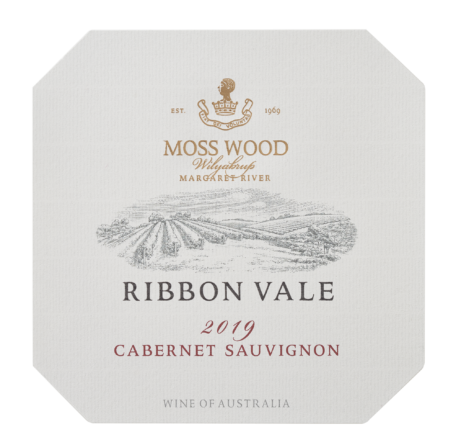Moss Wood Ribbon Vale 2019 Cabernet Sauvignon

| Wine Facts | |
|---|---|
| Median Harvest Date | Cabernet Sauvignon – 21/04/2019 Cabernet Franc – 10/04/2019 Merlot – 13/04/2019 Malbec – 10/04/2019 |
| Mean Harvest Ripeness | Cabernet Sauvignon – 12.8⁰ Be Cabernet Franc – 12.8⁰ Be Merlot – 13.0⁰ Be Malbec – 12.8⁰ Be |
| Yield | Cabernet Sauvignon – 5.65 t/ha Cabernet Franc – 5.27 t/ha Merlot – 6.22 t/ha Malbec – 5.24 t/ha |
| Day Elapsed between Flowering and Harvest | Cabernet Sauvignon – 138 days Cabernet Franc – 132 days Merlot – 131 days Malbec - 130 days |
| Bottled | 10th August, 2021 |
| Released | 29th October, 2021 |
| Alcohol | 14.0% |
Wine Facts
-
Median Harvest Date
Cabernet Sauvignon – 21/04/2019
Cabernet Franc – 10/04/2019
Merlot – 13/04/2019
Malbec – 10/04/2019
-
Mean Harvest Ripeness
Cabernet Sauvignon – 12.8⁰ Be
Cabernet Franc – 12.8⁰ Be
Merlot – 13.0⁰ Be
Malbec – 12.8⁰ Be
-
Yield
Cabernet Sauvignon – 5.65 t/ha
Cabernet Franc – 5.27 t/ha
Merlot – 6.22 t/ha
Malbec – 5.24 t/ha
-
Days Elapsed between Flowering and Harvest
Cabernet Sauvignon – 5.65 t/ha
Cabernet Franc – 5.27 t/ha
Merlot – 6.22 t/ha
Malbec – 5.24 t/ha
-
Bottled
10th August, 2021
-
Released
29th October, 2021
-
Alcohol
14.0%
Moss Wood Ribbon Vale 2022 Cabernet Sauvignon – Erin Larkin, The Wine Advocate
The 2022 Ribbon Vale Cabernet Sauvignon is chalky and chewy, with raspberry pip, nori, iodine, bramble and fresh leather. This is elegant and attractively “not” fruit driven; instead, it’s propelled by exotic spice and tannins that feel silken. It’s a magnificent wine, a postcard from Margaret River in a bottle….
Vintage notes
We hope readers enjoy our reports about seasonal conditions and how these impacted our winemaking lives. An important part of the fun in making and drinking wine is that every vintage is different and carries with it the stamp of the often-small weather variations that prevailed. The results are the nuanced but perceivable changes in the style of wine we made.
Our most interesting stories typically come from complicated years. The more Mother Nature throws out the challenges, the harder we have to work to achieve the high quality upon which we pride ourselves. As we progressed through the 2018/19 season, it became clear she was definitely in one of those moods.
Mild and wet, was the theme of the spring. Calendar year 2018 was above average for rainfall and it kept coming right till the end of the year. The Cabernet varieties all flowered late, around 20th November and were accompanied by 9 days of rain, delivering a total of 53mm, not to mention 10 days when the temperature dropped below 8°C. Flowering was at least a week late across all varieties and it’s no surprise that yields were variable. Good old Cabernet Sauvignon coped well and was actually up ever so slightly, by 2%, at 7.10 tonnes per hectare but the brothers-in-arms, Cabernet Franc, Merlot and Malbec were all below average to varying degrees. Cabernet Franc was the worst offender, down 34%, at 5.27 tonnes per hectare.
We kept our part of the bargain by keeping fungicide treatments on track and so the vineyard was free of disease. When the leaves are green and healthy, the vines are able to maintain good ripening, something quite crucial when the temperatures are a bit low, giving them the best chance to achieve good flavours.
Our other important step we can take is to make sure our foliage management is timely. When the shoots are properly positioned, standing vertically, with all the leaves and bunches exposed to the sun, we maximise the ripening potential and minimise the disease risk. In the sporting parlance, the 1%ers can really make a difference and attention to detail is critical.
As the season progressed all this became more and more important as Mother Nature gifted us on-going mild temperatures and several good dollops of rain. With the vineyard in good shape, disease wasn’t a risk but ripening was slow.
As dry land farmers, we have something of love/hate relationship with rain. We love to have it anytime but it’s a mixed blessing late in the season. As we progress into autumn, we get a bit edgy. Falling temperatures reduce the progress of the Cabernet varieties and rain slows things even further. By mid-April things can reach the point in cool years when ripening all but stops.
The other issue is the birds get very hungry at that time of year and although the crop is protected by nets, we have to check continually for holes. The silvereyes, in particular, will find the smallest opening to stream through and get stuck into the fruit. Nothing is more frustrating than watching the birds help themselves to almost-ripe grapes.
With all of the above in mind, it was a relief when Ribbon Vale closed in on full ripeness. On 10th April, we got under way with Cabernet Franc and Malbec, soon followed by Merlot. We were still waiting on Cabernet Sauvignon, anxiously following the many weather forecasts available these days and decided on Good Friday morning that Easter Saturday was the big day. We were experiencing some showers but they were likely to be easing by the afternoon, so we agreed to take the nets off late in the day. What happened next will remain one of those magic moments we’ll remember forever.
As the vineyard crew left Moss Wood, which luckily was all finished by this stage, to take off the aforementioned nets, an almighty storm passed over the top of the winery, leaving hail piled up against the south side of all the buildings. Very exciting indeed! As can happen with these things, it was a strip about 1 kilometre wide, passing roughly straight over the top of Moss Wood, with Ribbon Vale on the very southern edge, so fortunately it missed the worst. Also, believe it or not, we also need to thank the birds because their pressure meant we’d left the nets on until the very last minute and these prevented the hail from damaging the fruit. Sometimes you get lucky!
Production Notes
As always, the fruit for the Ribbon Vale reds was hand-picked and delivered to the winery where it was destemmed and sorted. Cabernet Sauvignon, Cabernet Franc and Malbec were all put into small, open fermenters, for hand plunging 3 times per day. Merlot went into closed fermenters and was pumped over 3 times per day.
All batches were seeded with multiple yeast strains for primary fermentation and temperatures were controlled to a maximum of 30°C. Time on skins was 10 days for Malbec, 16 days for Cabernet Sauvignon and Merlot and 17 days for Cabernet Franc.
After pressing all batches underwent malolactic fermentation in stainless steel and were then racked to barrel. All casks were French oak barriques, and in the Cabernet Sauvignon 26% were new and in the Merlot, 14%.
On 16th November 2020, the final blends for both wines were made up. The 2019 Cabernet Sauvignon is 91% Cabernet Sauvignon, and 3% each of Cabernet Franc, Merlot and Malbec. The 2019 Merlot is 93% Merlot and 7% Cabernet Franc. The finished wines were then returned to barrel.
In early August 2021, after 28 months in wood, both wines were racked to stainless steel and fining trials were carried out to assess tannin balance. No finings were necessary and so both were sterile filtered and bottled on 9th August.
Tasting Notes
Colour and condition:
Deep brick red hue; bright condition.
Nose:
This has “smouldering” Cabernet Sauvignon notes in the classic claret style - redcurrant, mulberry and lots of cigar box, cedar and tar.
Palate:
The wine is full-bodied and complex, with redcurrant and mulberry fruit flavours running the full length of the palate and the finish has toasty oak and firm but balance tannins.
Cellaring
This is most definitely a wine that will repay long term cellaring. It will take at least a decade to develop some bottle characters and will require at least a further 15 years to reach full maturity, which it should maintain for a further decade at least.

